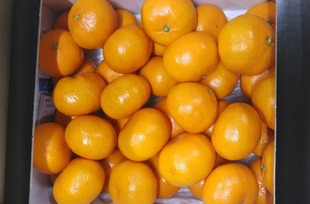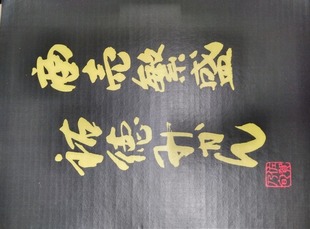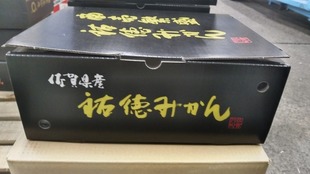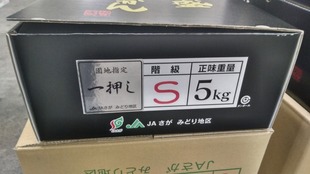御神酒合わせ・三三九度(おみきあわせ・さんさんくど)
【Product name】
Yutoku Mandarin Orange
【Type】
Citrus L.
【Wholesale area】
Kashima City, Saga Prefecture(JA Saga Midori District)
【Origin of the name】
Named after "Yutoku Inari Shrine(倉稲魂大神, 大宮売大神, 猿田彦大神)", the god of the prosperous business rush of business, famous as one of Japan's three major Inari shrines; Three generations of Kyushu god of cereals.
【Major features】
Hizen Hamashuku Sake Brewery Street in Kashima City (A region that developed mainly in the brewing industry of sake and soy sauce from the Edo period to the Showa period. In 2006, it was selected as a national "Important Preservation District for Groups of Traditional Buildings"): 300 years The Crucian carp market, a traditional Kashima city event, was held in the early morning of January 19, 2023 at Sake Brewery Street in Hizen Hamashuku. Funankogui, a local dish of crucian carp wrapped in kombu seaweed, is served on the 20th New Year (in the New Year's season, this day is considered to be the day of the New Year's payment or the start of work). The custom of offering remains. Like last year, there was only one stall selling live crucian carp. This market is rare even in Japan. More than 30 years ago, there were more than 10 shops, but this year there was only one. In addition, efforts to preserve the historic townscape of Hizen Hamashuku in Kashima City won the Asian Landscape Award sponsored by the United Nations Habitat Fukuoka Headquarters. It seems that the preservation and restoration of traditional buildings through industry-government-academia collaboration and the regeneration of them as tourism resources were highly evaluated. It is the first honor to receive an award in Saga Prefecture. "Yutoku Mikan" is the top brand among the "Saga Bijin" mikan, the unified brand of mandarin oranges produced in Saga Prefecture. It seems that only 1% of the mandarin oranges that pass the strict selection criteria are shipped as Yutoku mandarin oranges. “Saga Bijin” is a brand of Wenzhou mandarin oranges that the prefecture is proud of. It seems that even among the delicious unshu mandarin oranges from Saga Prefecture, only those that meet the uniform standards of the prefecture are named "Saga beauty" and shipped. The selection method is also strict, and must satisfy the high sugar content, moderate acidity, and good appearance. Products that meet these strict standards become “Saga beauty” and are sold in a wide range of areas throughout the country. In addition, the mandarin orange field is covered with pure white sheets that are waterproof and reflect the sun's rays. , a technology that limits the amount of water that the mandarin orange tree absorbs and increases the sugar content of the mandarin orange)”, so it grows into a “beautiful” mandarin orange that is sweet and has a beautiful color. Kompeito Co., Ltd. (Nishi-Gotanda, Shinagawa Ward, Tokyo) develops a stationary company cafeteria service "OFFICE DE YASAI (vegetables in the office)" in cooperation with local governments nationwide and JAs in various places, using dedicated refrigerators. We regularly hold regional special product fairs at our office. As the 20th step, in cooperation with JA Group Saga, as an opportunity to eat the actual food in 2022, from November 14th to 18th, about 100 sites, mainly companies in Tokyo and Osaka, will produce Wenzhou oranges “Saga Bijin” from Saga Prefecture. Sampling. On the night of February 8, 2021, at Yutoku Inari Shrine in Furueda, Kashima City (former Fujitsu District), the year-end Shinto ritual "Ohitaki'' (a ritual at the end of the year that has continued for more than 300 years) will be held from sunset to night on the precincts as a night ritual of the Niiname Festival. When the "Oyama" set up in the precincts is ignited, it burns all at once, creating a flame so large that it seems to reach the main shrine. If you are hit by this sacred fire, you will be healed of illness, and you will be healed of sins and uncleanness that you have unknowingly committed. It is said that the sacred fire is used to purify and purify and pray for happiness in the coming year. As an act of gratitude for the harvest and bestowing good fortune, rice is planted at the rice planting festival and new rice harvested at the nukibo festival. Worshipers are treated to amazake made from Under the winter sky, many worshipers gathered in the precincts, and it seems that they wished for happiness in the coming year while warming themselves with the red flames that burned up to a height of about 20 meters. Just before 8:00 pm in the deep darkness, the Shinto priest lights the 8-meter-tall "Oyama" made of bamboo and wood with a torch, and a pillar of fire rises at once as if to scorch the night sky. The shrine was dyed red. It seems that the worshipers prayed for good health by lighting the sacred fire. In 1687, 萬子-hime Kasannoin, the wife of Naotomo Nabeshima, the lord of the Hizen Kashima Domain (formerly known as Yutokuin), lived in harmony with shrines and temples until the Meiji government issued an edict to separate Shintoism and Buddhism in 1868. Yutoku-in was a Zen temple of the Obaku sect, and was a nunnery presided over by 萬子-hime, who ruled over a dozen nuns. Mankohime was born in 1625 to Kasannoin Sadayoshi (1599-1673), a court noble and former minister of the left, and the daughter of a court noble and former emperor's chief advisor, Nobuhisa Takatsukasa (1590-1621). At the age of two, she was adopted by her maternal grandmother, Imperial Princess Seishi, the third daughter of Emperor Goyozei. In 1662, at the age of 37, she married Naotomo Nabeshima, the third lord of the Hizen-Kashima clan, a branch of the Saga clan. He remarried at the age of 41, and her first wife, Hikochiyo, died in 1660. His father, Sadako KASANNOIN, faced farewell and transferred the divine spirit of Inari no Okami enshrined in his residence as a guardian deity of food, clothing and shelter from Fushimi Inari-taisha Shrine to a bronze mirror and bestowed it on Princess 萬子媛), but this was the imperial request office of the Imperial Court. An Inari shrine where the spirit of Inari Okami was enshrined, it is deeply worshiped by the people as a guardian deity of food, clothing and shelter. It is counted as one of Japan's three major Inari shrines, and various prayers such as the prosperous business rush of business, family prosperity, good catches, traffic safety, etc. The main shrine, the Kagura hall, the two-storied gate, and other parts of the temple, all painted in richly colored lacquer, are known as Chinzei Nikko, and stand out on sightseeing routes. The magnificent vermilion shrine building is characteristic, and it is also a place where seasonal flowers such as cherry blossoms and azaleas are beautiful. In autumn, it becomes one of Kashima City's best autumn foliage spots, attracting a large number of tourists from both Japan and overseas. The best time to see the autumn leaves is from mid-November to late November. Many places with beautiful autumn leaves are deep in the mountains where transportation is inconvenient, but this place is also attractive because it can be reached by a single bus from Hizen-Kashima Station, where the express train stops. "Kashima City Agricultural Revitalization Council Paddy Field Profitability Enhancement Vision" was announced based on the provisions of Appendix 11-3 of the Implementation Guidelines for Business Income Stabilization Measures. From 2021, the name will be changed from "Vision for Full Utilization of Paddy Fields" to "Vision for Strengthening Paddy Field Profitability". Current state of crop planting in the region, issues faced by the region: Effort policy as a production area for strengthening profitability, etc. Effort policy as a production area, etc. for effective use of paddy fields: Effort policy for each crop, etc. Planting for each crop Planned area, etc.: Efforts and targets for solving problems. Kashima City Agricultural Revitalization Council Vision for Full Utilization of Paddy Fields: Current State of Crop Planting in the Region, Issues Facing the Region In addition to producing land-use crops centered on wheat and soybeans, complex facility-use high value-added agriculture such as cultivation of greenhouse crops such as strawberries, tomatoes, and asparagus, and onion cultivation is being developed. Also, in the hilly and mountainous areas, it seems that fruit trees (Unshu mandarin oranges) are being cultivated mainly in the orchards developed by the government-run Taradake pilot project. On the other hand, with regard to the structure of agriculture, it seems that the aging of farmers has led them to quit farming due to labor instability, and the outflow of young people, who are the successors, to the outside of the city due to the lack of farming. In addition to land-use agriculture, uncultivated farmland is increasing in a wide range of areas, including hilly and mountainous areas. It seems that the further formation of Staple rice as a policy for each crop: The Kashima region has been promoting planting in line with production volume targets. "Hinohikari rice" is 16 ha, "Saga Biyori rice" is 284 ha, and "Hiyokumochi rice" is 166 ha. From 2018 onwards, they will work on producing staple food rice based on a planting plan in line with the "production guideline" presented by the prefecture and the prefectural council, while basically producing according to demand. In particular, we will actively promote “Saga Biyori Rice” and “Yume Shizuku Rice” that have acquired Special A. Based on this, if there is still a shortage even after making adjustments within the region, it seems that support will be provided so that rice production that meets the needs of the field will be supported by utilizing coordination between regional councils. In addition, it seems that rational land use, efficient work and cost reduction will be achieved by reducing organic matter (straw), labor saving by joint raising seedlings, and promoting and expanding direct sowing in water. As a non-staple food rice, it is necessary to solve various problems related to production, processing, distribution, and use of feed rice. As demand for rice is expected to decline, it seems that they are considering switching to high-yielding varieties of rice for feed using local subsidies, and are discussing the promotion of such efforts with relevant organizations. In food, it is widely known as a spice used in European cuisine such as saffron rice, paella, and bouillabaisse. In addition, it is the only flower in the world that is treated as a medicine, and it seems that it is used for coldness etc. because it promotes blood circulation. Recent research seems to confirm that there are other benefits as well. As an initiative in Kashima City, it seems that saffron cultivation is being carried out using fallow fields in the "Hayanose district", which is a mountainous area in the Nogomi district. The area is excellent as suitable land for growing saffron, and since it is light work, even the elderly can work on it, and once planted, it does not require maintenance. In addition, it is attracting attention as a fragrant and healthy ingredient, and there is a demand for it, so it seems that it is expected that the collection of pistils will create employment and lead to the revitalization of the region. Wait for purple flowers to bloom in indoor pots. The red flower lotus in the center of the flower looks like a pistil. In addition, we will discover the charm of secluded places in the mountains, create agricultural production plans unique to the region, maintain and continue agricultural production activities, and create a rural (mountain) community by suppressing the progress of devastation in secluded places in the mountains. It looks like they're trying to improve the scenery. “Kashima City”, From the Gisuke flat cave (Furueda), earthenware such as streak and stamped patterns, which are said to be from the early Jomon period, have been excavated, and people have already lived in a part of the foot of Mt. Tara for thousands of years. I know that. During the Yayoi period, relics were distributed in alluvial fans such as the Kashima, Nakagawa, Hamakawa, and Shichiura coasts, and it is speculated that the Yayoi people were fishermen who lived on fish and shellfish from the Ariake Sea. The place name of Kashima first appeared in the history book in the book “Engi-shiki” (927), which says “Hizen Province Kashima horse maki”, and it is presumed that it played the role of the station building at that time. In addition, it seems that most of the current Kashima city belonged to “Nomi Township” in Fujitsu District, which is located in “Hizen no Kuni Fudoki”. Since the Middle Ages, Mr. Omura, who is based in Furueda, has been in power in this area, but in the Warring States period, he became a sphere of influence of Mr. Arima. In the early modern period, the administration was transferred to Mr. Nabeshima under the rule of Mr. Ryuzoji. The Kashima branch domain began in 1609, about 400 years ago, when the first feudal lord, Tadashige Nabeshima-Ko, was allowed to know in Fujitsu District, and has ruled the land of Kashima for 13 generations. After the Meiji era, local autonomy as a subordinate organization of the central government began, and there is a history of rapid consolidation and abolition due to the county system and town / village system. In modern times, the Kashima Municipal System was established by the merger of the five towns and villages of Kashima Town, Nogomi Village, Furueda Village, Hamamachi, and Kashima Village on April 1, 1954, according to the 1953 “Municipal Merger Promotion Law”. It started. On March 1, 1955, the then seven ura villages (excluding Ifuku) merged, and the current Kashima city was established. The city is located in the southwestern part of the prefecture, with the Ariake Sea spreading to the east and the Mt. Taradake mountain range to the west, and is blessed with a natural environment. According to the 2015 census, the number of households is about 10,000 and the population is about 30,000. As for the transportation system, National Highway No. 207 runs in parallel with the Nagasaki Main Line, and the JR Nagasaki Main Line is about an hour away from Fukuoka City and Nagasaki City. In the city, valuable historical townscapes remain nationwide in the Hama district and Omuragata district of Furueda, but these precious townscapes are gradually breaking down or disappearing and cannot be maintained by individual power alone. It's done. It is said that it is planning to preserve this important historical heritage until the age of children and grandchildren, and to utilize it for creating an image of the city and tourism resources to promote the city and Hizenhama inn. On April 21, 2006, the two districts in Hizenhama inn were simultaneously selected as the “Important Traditional Buildings Preservation District (Important Preservation District)” by the national government (Agency for Cultural Affairs), and Kashima City is proud of its nationwide. It has been certified as a valuable historical heritage. This area is a post town for repatriation of Tara on the Nagasaki Highway, and it seems that the brewing industry and the fishery processing industry prospered as a port town facing the Ariake Sea. Hama Town Water and Minori Meeting: The Hama district is a hilly and mountainous area located in the western part of Kashima City. National Route 207 Bypass and the JR Kyushu railway run through the center of the area, and commercial facilities and residential areas are concentrated in between. There is a use zone of the city planning area. In the reclaimed land in the northwest, rice, wheat, soybeans, and onions are cultivated using well-maintained paddy fields, while mandarin oranges and vegetables are cultivated in the sloping mountainous areas. However, in addition to the lack of successors and bearers, the increase in the cost and labor burden of maintenance and management of irrigation ponds, headworks, and waterways to secure agricultural water, damage to wildlife such as wild boars, and the expansion of devastated land in the surrounding area. They have many problems such as the increased burden of maintenance and management of farmland and agricultural facilities, but they seem to be working on various issues in the region while making use of this subsidy. Multifunctional Payment Grant Project: The rich farmlands, farm roads, and agricultural irrigation canals in the town where residents live in Kashima City are not only related to agricultural production, but also multifaceted such as community roads, domestic drainage, and fire prevention water. It has a role and forms the living environment and landscape, and its benefits are enjoyed by all the residents living in the area. For this reason, the cooperation of the entire community is essential to protect these rural environments and pass them on to future generations. The mandarin oranges, which are abundantly ripened by the gentle sea breeze of the Ariake Sea, are in season from October to February every year. Raised with great care, Kashima mandarin oranges are popular for their sweet and juicy taste.
Bare ground mandarin oranges have a long history of being cultivated mainly at the foot of Mt. Tenzan, which crosses Saga Prefecture, and at the foot of Mt. Taradake, which is located in the southwest and overlooks the Ariake Sea. Orange Belt (Kashima City and Tara Town since 1964). The Orange Kaido, which crosses the foot of Mt. Taradake, is a wide-area agricultural road that runs along the coast of the Ariake Sea. In the winter season, yellow mandarin oranges spread out before your eyes. The steep erosion valley of Mt. Taradake, which used to be a volcano, is connected by a long bridge in a straight line and connected to the Taradake Rainbow Road on the Nagasaki Prefecture side). In addition, the production of branded mandarin oranges is flourishing. Among the delicious unshu mandarin oranges from this prefecture, only those that meet the uniform standards of the prefecture are named "Saga Bijin" and shipped.
“Yutoku” is named after “Yutoku Inari Shrine”, a god of prosperous business, which is famous as one of Japan’s three major Inari shrines in Kashima City. The precincts consist of a tower gate, a Shinto music shrine, a main shrine, etc., and it is affectionately known as "Chinzei Nikko: Kyushu's Nikko Toshogu Shrine" due to its gorgeous and vivid appearance. Beyond the main shrine, there is a vermilion torii gate leading to Okunoin.
The selection method is also strict, and it seems that the high sugar content, the right amount of acidity, and the good appearance must be satisfied. "Yutoku mikan" is the highest grade Saga mandarin orange that is shipped after stricter selection than Saga Bijin. It's only for a limited time, so don't miss the shipping time!
The Midori district of the Saga Prefectural Agricultural Cooperative is located in the southern part of Saga Prefecture and consists of Takeo City, Kashima City, Ureshino City, and three cities and three towns: Omachi Town, Kohoku Town, and Tara Town. Taking advantage of the flatness of the Ariake Sea and the mountainous terrain, the company produces a wide variety of agricultural products. Producers who raise pigs in Wakaki Town, Takeo City gathered together with the desire to provide healthy and delicious meat that takes into consideration technical improvements and environmental measures. Named "Wakakusu Pork" after the natural monument "Kawako no Okusu", which is a natural monument of Kawago. After that, he participated in local events, etc., increased his name recognition, and acquired a trademark registration in 2006. The appeal of this pork is All union members introduce sows produced at one member's farm to unify the sows, and healthy sows with strong limbs produce healthy piglets that inherit the blood of the sows. Born with a healthy body and raised in the rich natural environment and clean water of Wakaki-cho, the pork has little smell and is loved for its fine, tender meat.” It seems to have established itself as a branded product. In addition, in horticultural crops, we are working on priority items such as the brand tangerine 'Saga Bijin' mainly in the Kashima and Tara districts. Vegetables are mainly onions, strawberries, and cucumbers, and it seems that they are also working on the production of lightweight vegetables such as bok choy and asparagus. Ureshino Town is known as one of the leading tea-producing regions in Japan, and is known as "Ureshino Green Tea (the shape of the tea leaves is rounded like a comma-shaped bead), and is called Guri green tea. It is called green tea, and is characterized by its refreshing aroma and rich umami. Also, when it is roasted in an iron kettle, it is called kamairisei tamaryokucha, which is fragrant and has a refreshing taste.) It gets high marks every year.






